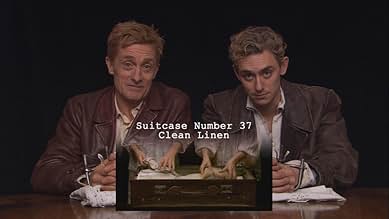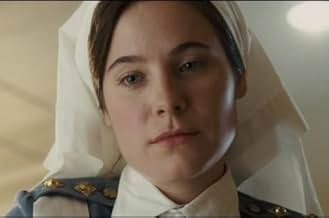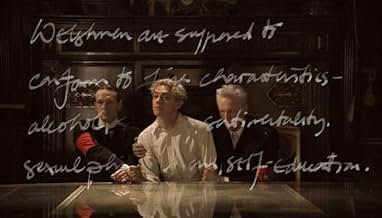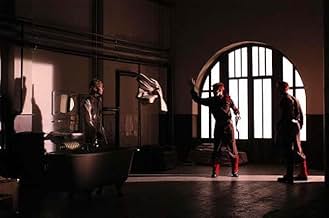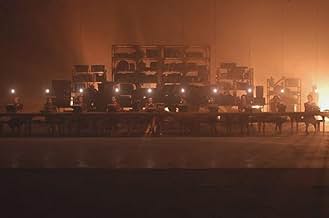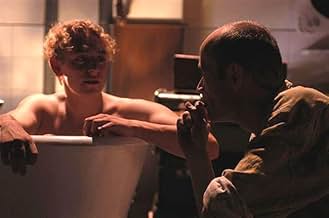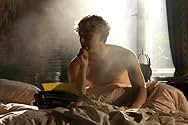Las maletas de Tulse Luper: La historia de Moab
Título original: The Tulse Luper Suitcases, Part 1: The Moab Story
PUNTUACIÓN EN IMDb
6,7/10
1,3 mil
TU PUNTUACIÓN
Tulse Luper de niño durante la Primera Guerra Mundial, como explorador en el Utah mormón y como escritor en Bélgica durante el ascenso del fascismo.Tulse Luper de niño durante la Primera Guerra Mundial, como explorador en el Utah mormón y como escritor en Bélgica durante el ascenso del fascismo.Tulse Luper de niño durante la Primera Guerra Mundial, como explorador en el Utah mormón y como escritor en Bélgica durante el ascenso del fascismo.
- Dirección
- Guión
- Reparto principal
- Premios
- 1 premio y 1 nominación en total
Jordi Mollà
- Jan Palmerion
- (as Jordi Molla)
Nilo Zimmermann
- Pip
- (as Nilo Mur)
Reseñas destacadas
10vdg
How can I write something about this movie
as it's almost impossible to write a review about such a film! Get all the other Greenaway's movies, add a doze of Gillian and Lynch and you can get an idea about what this movie is all about it. I think the students that learn about what film editing means, should use this film as the most perfect example. Multiple scenes flying across the screen, multiple dialogs, theater-like atmosphere and a good music score, adds up to create a unique experience! I have to reckon that I had big expectations about this movie, after reading the reviews, seeing the web site related to the whole story, and of course, seeing all the other Greenaway's movies
and I was not disappointed- this film is something that I have waited to see since long time ago: a blend of reality, imagination and a perfect manipulation of movie editing.
Definitely this movie should be seen in the theater, as its just too small for a normal TV-there is so much information on the screen or maybe if you have a projector at home:)
There are probably lots of `mistakes'(like a very hard to follow script, too many characters...etc) in this film, and many people would not understand a thing, but this is just normal, because there is no other movie that can be compare with this one!
IF you love art movies, and you are prepared to give some `food' to your brain, then see this movie, you won't be disappointed.
Probably, Greenaway's idea of creating this multimedia Magnus Opus would be doomed to a commercial failure, but for the real art lovers, I think the movies created for this project would set a landmark.
10 out 10
Definitely this movie should be seen in the theater, as its just too small for a normal TV-there is so much information on the screen or maybe if you have a projector at home:)
There are probably lots of `mistakes'(like a very hard to follow script, too many characters...etc) in this film, and many people would not understand a thing, but this is just normal, because there is no other movie that can be compare with this one!
IF you love art movies, and you are prepared to give some `food' to your brain, then see this movie, you won't be disappointed.
Probably, Greenaway's idea of creating this multimedia Magnus Opus would be doomed to a commercial failure, but for the real art lovers, I think the movies created for this project would set a landmark.
10 out 10
Peter Greenaway likes drugs and attempting to differentiate his movies from others. I've seen a few of his other movies before this one and I'm really not much of a fan. I simply don't care for his style but I still respect him somewhat as he doesn't seem to care about living up to peoples expectations. He seems to have plenty of original ideas but it seems as if he never seems to care about perfecting them and bring them out in the most cockneyest of ways. With that said this (along with the whole project) to me doesn't seem much more than a concept... most of the effects (some of which have been used by Greenaway in his previous films) aren't used to their full potential but are used well enough to prove that they can. This might not be an excellent film but it certainly isn't a bad one.
I have three living filmmakers that I revere. Greenaway, of course, is one of them and the most obstreperous of the bunch. I like that he has real problems with making illustrated books and does something substantial out of that.
His fundamental notions of the world are built on overlapping conceptual frameworks, ordered frameworks. In this, he follows the Joycean tradition of "Finnegans Wake," which layered all sorts of frameworks from Kabbalistic, Vican, mythological, even geographic sources. It was all merged according to a dream logic since we had no other template in that day and used every lexical and literary device he could muster.
Where Joyce had to make do with dream-layering, our Peter gets to use already familiar web- referenced multimedia overlays. He surely knows how to use the software to extend the art of editing into new dimensions. Wow, just on that score.
And where Joyce used obtuse frameworks with the intent of his book being a life's reading, Greenaway uses obvious overlapping frameworks: numbers, his own life and the mythology from his prior films. Some categories, like the periodic table. Oddly, he hasn't been as thorough in this film as he has in some others: Vermeer's theories of light, animals, sexual stereotypes, the written word, various frameworks of introspection and reflection. Different slices on gender.
Anyway, the point is that where Joyce was esoteric, Greenaway strives to be obvious, though manylayered, even juvenile, in his frameworks. He wants these to be so simple and grand that he can stretch them to many web sites, films, CDs, games, and (I presume) books and installations. Someone can casually enter a part of the larger work and intuit the order of the thing.
Each fan of Greenaway will have to make her own decisions on what she likes in terms of the different balances he has struck. As for me, I want a tighter integration of framework and image than he has here. This is why I value his "book" films the highest.
What does this add to what we have? Sadly, not much, except an attempt to integrate himself and some of the political sweeps of the ordinary world, which he tags to nuclear control. I've often thought that the artists themselves are dumber than the art they produce and the greater distance we have from their personalities, the better.
If you have talked to Greenaway, you'll see this in a flash. He has some good headlines, having to do with the bankruptcy of narrative in film. But beyond that, his films (some of them) soar, while his own spoken narrative crawls.
Ted's Evaluation -- 3 of 3: Worth watching.
His fundamental notions of the world are built on overlapping conceptual frameworks, ordered frameworks. In this, he follows the Joycean tradition of "Finnegans Wake," which layered all sorts of frameworks from Kabbalistic, Vican, mythological, even geographic sources. It was all merged according to a dream logic since we had no other template in that day and used every lexical and literary device he could muster.
Where Joyce had to make do with dream-layering, our Peter gets to use already familiar web- referenced multimedia overlays. He surely knows how to use the software to extend the art of editing into new dimensions. Wow, just on that score.
And where Joyce used obtuse frameworks with the intent of his book being a life's reading, Greenaway uses obvious overlapping frameworks: numbers, his own life and the mythology from his prior films. Some categories, like the periodic table. Oddly, he hasn't been as thorough in this film as he has in some others: Vermeer's theories of light, animals, sexual stereotypes, the written word, various frameworks of introspection and reflection. Different slices on gender.
Anyway, the point is that where Joyce was esoteric, Greenaway strives to be obvious, though manylayered, even juvenile, in his frameworks. He wants these to be so simple and grand that he can stretch them to many web sites, films, CDs, games, and (I presume) books and installations. Someone can casually enter a part of the larger work and intuit the order of the thing.
Each fan of Greenaway will have to make her own decisions on what she likes in terms of the different balances he has struck. As for me, I want a tighter integration of framework and image than he has here. This is why I value his "book" films the highest.
What does this add to what we have? Sadly, not much, except an attempt to integrate himself and some of the political sweeps of the ordinary world, which he tags to nuclear control. I've often thought that the artists themselves are dumber than the art they produce and the greater distance we have from their personalities, the better.
If you have talked to Greenaway, you'll see this in a flash. He has some good headlines, having to do with the bankruptcy of narrative in film. But beyond that, his films (some of them) soar, while his own spoken narrative crawls.
Ted's Evaluation -- 3 of 3: Worth watching.
i had read a review of this and the 92 DVDs that are part of the project-and essenetially the project itself rather than the actual film- really interested me. unfortunately only the film is available to see and even though it had a certain spirit it was mostly a struggle to watch. there are some films, where one has to give up on trying to follow a strict narrative or a plot, but rather follow the mood and the visuals and the emotion that the film evokes. "Tulse Luper" seems to be that at the get-go. i was curious and i watched patiently, but the more i watched the more it seemed the technique itself cannot be the most interesting thing going on, especially when the film is only a part 1 and I will have to wait indefinately to see a conclusion. be creative, but be lively and inventive across the border, not just in edit. i think the Pillow Book offered more to the senses and its visual style better served the story.
having said all that i still really badly want to see the project as a whole
having said all that i still really badly want to see the project as a whole
This film is the nth Wonder of the World. It's just so unashamedly full of details, pictures in pictures, special effects, not so special effects, special and unspecial characters, kids, lists of lists, colors, sets, music that puts other, more franchise-y trilogies such as Matrix and Lord of the Rings to shame, plot, plot, plot, perspectives and fiery dialogue about America, Europe, war, sex, friendship, family, torture, dentistry,... It's nominally about stuff like imprisonment and 20th century history, but it's really all about the limits of film and the artist's ability to satirize his own extremism. And the tracking-shots are just stupid, in a good way. And it's completely insane. And so funny I was shaking and bit my chewing gum in half. It never stops. I think P.G. ran out of money --- the sequel wasn't too great --- which is a shame, he's been planning this for years. Anyway, I believe I enjoyed this film. And hey: I love Ferris Bueller's Day Off and Braveheart too.
¿Sabías que...?
- Curiosidades'Cissie Colpitts' is the name shared by the three main female characters in Conspiración de mujeres (1988), by the same director.
- ConexionesEdited into The Tulse Luper Suitcases: Antwerp (2003)
Selecciones populares
Inicia sesión para calificar y añadir a tu lista para recibir recomendaciones personalizadas
- How long is The Tulse Luper Suitcases, Part 1: The Moab Story?Con tecnología de Alexa
Detalles
- Fecha de lanzamiento
- Países de origen
- Sitio oficial
- Idiomas
- Títulos en diferentes países
- Les maletes de Tulse Luper: La història de Moab
- Localizaciones del rodaje
- Empresas productoras
- Ver más compañías en los créditos en IMDbPro
Taquilla
- Presupuesto
- 10.000.000 US$ (estimación)
- Recaudación en todo el mundo
- 90.071 US$
- Duración
- 2h 7min(127 min)
- Color
- Mezcla de sonido
- Relación de aspecto
- 1.85 : 1
Contribuir a esta página
Sugerir un cambio o añadir el contenido que falta

